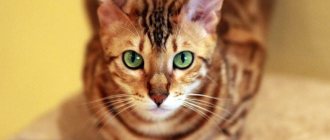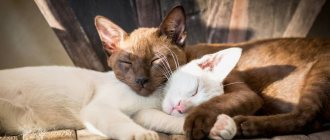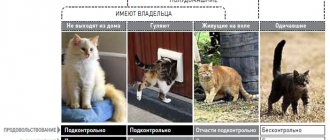Even those who do not consider themselves fans of cats cannot help but agree that they are special and mysterious creatures. Today we will reveal one of the secrets of furry pets and tell you what kind of memory cats have, its types, how long and how much information is stored in cats’ heads. You will also learn how memory and aging are connected, and whether it is possible to develop an animal’s memory.
Eh, I should have not missed the moment then...
Today, people know a lot about cute four-legged pets that can captivate anyone with their hypnotic gaze. But what is hidden behind the beautiful eyes: is it just curiosity or do cats, to one degree or another, remember what they look at?
First of all, let's understand the concept of memory. It is considered one of the highest mental functions responsible for the accumulation, preservation and reproduction of acquired knowledge and skills. It helps to navigate time and space, build relationships and accumulate experience.
Cats' memory is organized differently than humans'. The cat remembers only the information necessary for it, for example, where the tray is, a warm place, what can cause pain, or the sound of food being poured into a bowl. But she does not recognize her cub in an adult cat, since this is insignificant for them and will not help them survive in any way.
Instinct tells the cat that kittens need her care not throughout their lives, but only for a few months
Cat brain structure
A cat's brain weighs only 0.9% of the animal's total body weight. For greater clarity, it is worth mentioning that the human brain weighs 2% of body weight, and the canine brain weighs 1.2%. But as you know, size doesn't matter. The cerebral cortex is primarily responsible for analyzing information coming from the auditory organs. In a cat it consists of 300 million nerve cells, while in a dog there are half as many.
The structure of a cat's brain is 90% the same as a human's
The interaction of the organs of smell, touch and vision with the pet’s brain also occurs through the cortex. The gray matter of a cat's brain is designed to carry out vital actions (heart contractions, yawning, blinking). The cerebellum acts as a kind of “motor” for the pet. It is responsible for walking, running, jumping and the ability to maintain balance.
Hormones produced by the cat's brain regulate most of the pet's body functions. For example, oxytocin (stimulates the process of labor) and antidiuretic hormone (regulates urine concentration) are produced by the hypothalamus, and growth hormones and melatonin (involved in the regulation of sleep and wakefulness) are produced by the pituitary gland.
The cat's brain consumes 20% of the blood pumped by the heart
The connection between the brain and the central nervous system determines the cat’s ability to acquire and apply new knowledge, experience a wide range of emotions and demonstrate certain behaviors.
Memory
Animals immediately forget minor information and, unlike humans, do not store in their memory what is not important for a prosperous existence.
For wild cats, which lead a predominantly solitary lifestyle, such an adaptation mechanism is of great importance. Instincts and memory. Scientists have repeatedly tried to answer the question about the capacity of a cat's memory. However, it is not possible to separate such complex mental functions as perception, memory and learning from instincts. Innate elements of behavior in mammals are inextricably linked with life experience, so it is impossible to say with certainty which actions the mustached-striped one has learned from memory and which it performs at the behest of instinct.
It would be more correct to think that with experience the polishing of genetically embedded knowledge and stable memorization of information occurs:
- hunting rituals are based on the instinct of a predator, but luck is honed through training with each new attempt;
- the algorithm for communicating with relatives is confirmed by socialization;
- caring for offspring is based on parental instinct, but with each lambing, the mother cat acquires practical skills and dexterity.
Trainers believe that cats cannot count, since no one has yet managed to put on a show with a tailed mathematician. However, the mother cat instantly detects the shortage of kittens, “comparing” the current picture with the familiar one and imprinted in memory. This “absence effect” allows cats to sense the departure of one of the family members or a change in the interior of the apartment.
Memory and sensitivity. Undoubtedly, the mental activity of cats is much poorer than that of humans, and their memory capacity is less.
It has been established that cats can retain in long-term memory and subsequently recognize only a few individuals or places. At the same time, the reliability of information storage is quite high and allows cats to perform truly fantastic actions.
For example, there are widespread cases of cats returning to their previous place of residence despite the distance. In Murmansk, they even decided to erect a monument to a local celebrity: a traveling cat named Semyon returned home from Moscow, having covered 2,000 kilometers in 6.5 years.
The most susceptible age of a kitten is considered to be from 2 to 8 weeks, when intensive formation of brain structures occurs along with body growth.
If the baby has not seen people or had contact with them during the specified period, then it will be difficult to tame him later. It is on the sensitivity of the psyche that the process of domestication of young jungle cats, ocelots and cheetahs is based.
Can a cat remember?
There is an opinion that for cats it doesn’t matter who is next to them, only comfort matters. Perhaps they don't remember the owner?
Due to their nature, cats do not show much affection, but, in fact, they know their owner. It would be more correct to say that they feel: it is unlikely that appearance plays a significant role in how cats recognize their owners. Rather, their developed sense of smell, touch and hearing allows them to do this.
Mustachioed stunt performers are the best proof of their ability to remember
Vision for felines is not the main organ of perception. They paid for their ability to see in the dark with the inability to distinguish most colors familiar to people. They only distinguish yellow-green, blue and gray shades well. Fluffy pets have difficulty distinguishing between objects closer than half a meter and static objects, although they can detect the slightest movement from 900 meters away.
Does the pet remember its owner?
Of course, he remembers, but for cats we are all alike: the cat recognizes us by smell and voice. The person who constantly lives nearby plays a significant role in the pet’s life. This is a source of food, security, affection, warmth, and also a pleasant companion with whom you can play. Of course, a cat will not forget the person who makes his life comfortable. It is difficult to say how long the owner’s pet remembers. There are many stories of cats returning to their previous owners after a few months or even a few years.
Photo source: pixabay.com
Long-term and short-term memory
What are these features of the memorization process associated with? This is primarily due to the presence of 2 completely different types of memory:
- short-term - a process of relatively short duration (a few seconds or minutes), but sufficient for accurate reproduction of the events that just occurred;
- long-term is characterized by the relative duration and durability of the preservation of the perceived material, a kind of “storehouse” of knowledge.
Which one is most developed, how long does a cat’s memory last, is it good?
Duration of information storage
During the experiments, it was revealed that cats remember the location of hidden goodies for 16 hours. Dogs can forget about it after just 5 minutes. Scientists have not yet established much about the long-term memory of cats. For events to be transferred into the long-term, they must have some vital significance for the animal so that they can make a choice and save this event for the future.
Cats have selective memory: they remember especially well everything related to food, since this topic is vital in the wild.
Cats have well-developed visual memory, but... only if no one interferes with them in the process of memorizing. This means that cats are able to remember any obstacle in their path for only about 10 minutes. If you distract your pet at this time, the cat forgets that it must “step over” the obstacle not only with its front paws, but also with its hind paws.
Scientists discovered this when they conducted several simple tests in which they gave the cat a task and solution, and then quickly distracted it. They recorded the amount of time it took to completely distract the cat from the primary task. They found, surprisingly, that the kitten retained its short-term memory 10-20 times longer than most other animals. By comparison, humans' short-term memory lasts only 30 seconds or so.
A cat's short-term memory is 20 times better than yours.
Learning ability
A caring owner is concerned not only with the question of what kind of memory cats have, but also whether it can be trained in order to increase the mental abilities of the pet. As zoologists assure, this is not necessary, since the kitten is taught all the necessary skills by its mother. When living together with an adult in the same house, he will observe and learn from her. If the kitten was weaned from its mother early, it will still learn the skills necessary for life, but at the level of its own instincts. If a person still needs to influence this natural process, then this can be done in several ways.
- Add more vitamins to your pet's diet.
- In addition to food, give natural products, in particular fish and meat.
- Carry out training on your own, for example, moving a bowl or bed to a new place, and then check how quickly the individual gets used to the new conditions.
- You can let the kitten out for a walk and see if he finds his way home on his own, but at this time you need to carefully monitor him so that he does not get lost.
According to zoologists, the optimal age of an animal for memory development is 2–5 years.
How much information does a cat have in his head?
It is believed that in the brain of a cat (or any carnivores) there are two types of memory: instinctive and acquired. The latter accumulates during training, that is, the kitten will not be able to catch prey until the mother cat teaches him to do this. First, the information is sent to the so-called short-term memory center, and if the training is not repeated, it ceases to be important and is simply erased as unnecessary.
Cats store only significant events in their memory, and those that carry negative emotions can be remembered for several months, or even longer.
A cat can remember the person who offended him for the rest of his life.
Previously, it was believed that only humans had episodic memory (the kind in which life events are stored in conjunction with context), but recently more and more evidence has emerged in favor of the existence of this type of memory in animals. In the course of various experiments, experts have found that cats can actually remember the event as a whole, that is, for example, not just the fact of tasty food, but also some of the details that accompanied it (in particular, the dishes in which the food was located).
It has not yet been possible to establish how many memories, events and people cats can remember. The difficulty is that it is impossible to understand whether animals act instinctively or from memory.
Details
Mechanics of cat memory
Human memory differs in mechanics from cat memory in one more aspect. A person quite easily assimilates a large amount of information, and this information does not necessarily relate to ensuring his life. Often a person remembers something that may never be useful to him in practice. It's not like that with cats. The animal remembers only those facts that will later be used to satisfy primary needs
Please note that the cat remembers where the food is and when it is hungry, it pulls you to this place. The cat remembers where the treats are put away, where the tray is and whether it is clean
She doesn’t remember the TV series that she may have watched while sitting next to the owner. This is simply of no use to her and is not applicable to her life support.
An interesting confirmation of the short-term nature and selectivity of memory is the moment a cat raises kittens.
As a female cat, it is important to remember the algorithm for feeding and training kittens. She improves it with every litter
But after the cat grows up, it forgets about its offspring. She has already let him go into adulthood and no longer experiences any tender feelings.
Also, a cat, having learned to open cabinets in the kitchen in one apartment, does not immediately begin to do this in a new one. Yes, she is familiar with the subject, yes, the algorithm of actions does not immediately disappear from her brain, but nevertheless, before repeating the skill in a new room, she will study it again in order to compare the experience accumulated in memory and apply it.
Memory capacity in cats
The cat's brain stores just the right amount of memory that is important for survival. Yard cats remember how to behave with people, what to expect from dogs and how to behave in a concrete urban in order to survive.
A domestic cat does not need to remember the survival algorithm, but is very good at filtering information into its brain, for example, about guests and strangers in the house. You've probably noticed that a cat remembers regular visitors, even if it's a caregiver. And he may not perceive people close to you at all, who are rarely in your home.
Also, the cat will always remember the one who offended her. Be sure that the cat will remember an attempt on the tail, squeezing or an unpleasant voice. The cat also remembers the pranks of children, so if it is ever offended by a child of a particular age group, the cat will treat all other children with distrust and sometimes with aggression.
INTERESTING: a cat always remembers its owners. Even when lost, a cat remembers its person by smell, even if a lot of time has passed. But forgetting how he got lost last time is not uncommon. This is evidenced by the facts of domestic cats repeatedly escaping through the entrance.
Aging and memory
As with all living things, aging can manifest as memory deterioration. In old age, cats experience loss of space (they may forget where the bowl or tray is), lack of interest in previously favorite things, reluctance to communicate, depression, excessive appetite or its complete absence. Fortunately, not all cats suffer from such ailments.
Age, unfortunately, does not spare anyone
To reduce the risk of such disorders, do not forget about proper nutrition, monitor your pet’s weight and promptly contact a veterinarian for treatment of chronic diseases.
Interesting Facts
The memory of cats can be called a unique and completely unstudied phenomenon, if we list at least some of the cases of pets returning home.
A family that traveled from the Rostov region to Lugansk to visit relatives lost their cat Barsik, who was afraid of the dog in the new house.
A little more than a month passed, and the fugitive returned to his home, having covered a distance of more than 200 km.
A similar story happened in 1963 with the French cat Mumusu. They also took him with them to stay and lost him. The pet returned home almost a year later, having traveled 750 km.
The English cat Mack, although he did not find his home on his own, did not forget his owner even after 6 years of his ordeal. He disappeared while traveling through the canals. Volunteers identified the pet after a long time using its chip and returned it to its home. Mac happily rushed to his beloved owner.
But the most unique case happened with the cat Semyon, to whom a monument was erected even in 2013 in Murmansk. He walked from Moscow to his hometown for 6 years, covering more than 2 thousand km. And he arrived safe and sound, but very thin. And even though bronze Semyon does not look like a slender Siamese, it is not even a monument to a pet, but to his love, devotion and memory.
Cats' brain function declines as they age
Older cats may develop a disease similar to Alzheimer's disease. Feline cognitive dysfunction syndrome is associated with the aging of the brain and can lead to symptoms such as depression, spatial disorientation, and inappropriate behavior. Everything is the same as in humans, but, fortunately, not all people and not all cats are susceptible to this disease.
A cat is smarter than an iPhone
With each new generation, our smartphones and tablets become more powerful and faster. But they are still very far from cats! For example, the internal memory of an iPhone does not exceed 64 gigabytes. And a cat’s long-term memory can contain up to 91,000 gigabytes of information! At what speed do computers and cats process information? The iPhone processor produces about 170 million computational operations per second. And the cat’s brain performs 6 trillion operations during the same time! 6 trillion is 6000000000000, or six million million.
Photo: ntouch.roberts/CC
— 9 little-known facts about cats — Cat people are smarter than dog people
the science
Memorization speed: how to train your pet so that he remembers everything
By their nature, cats are independent and willful; they do not have the desire to please their owner, like dogs. Therefore, they are most amenable to learning actions for which they are initially inclined.
- The most optimal age for starting training is considered to be 6-9 months, when the nervous system is formed, but habits and character are not yet there.
- You should not teach an animal several commands at once in a short time.
- Don't forget to reward them with something tasty.
- Enter commands during play, when the cat is in the best mood.
- Try not to yell at your pet so as not to lose his trust.
- There is no need to overtire your cat; five minutes a day is enough for the first “lesson”.
Does the cat remember what happened to it many years ago?
Cat old age: what to change in the conditions of detention
Cats are very good at remembering past events if they aroused strong emotions in them. For example, a cat that was thrown into the bushes by its ruthless owners right in its carrier will be terribly afraid of carriers and all closed spaces all its life, because it received truly unforgettable emotions during its stay in it.
There is also the so-called memory of ancestors, when a cat, no matter how domesticated it is, will always hunt birds and mice that come into its field of vision. This is due to the special instinct of the hunter, which is inherent in every cat by nature and is unlikely to ever be eradicated.
Is it possible to develop a cat's memory?
Cats can very quickly lose acquired skills, especially if they say commands in situations inappropriate for their execution. In such cases, the pet will become confused and will soon stop responding to your words.
A cat does not remember an event or object until it encounters it again or until such a need arises, since dreams, fantasies and ephemeral images have nothing to do with the skills necessary for survival.
Success in training depends on the individual characteristics of the pet
Any success must be reinforced with praise or a treat. Don't make mistakes in your actions. For example, if a cat follows the command “sit” and at the moment of reward she stands up, then she will develop a connection between raising her hind legs and the treat. Thus, she will simply misunderstand you.
Learning ability
Learning is inextricably linked with memory and is based on the adaptive mechanism of acquiring and assimilating information. In everyday life, domestic cats remember the algorithm of actions and marker words if they are repeated a certain number of times and lead to the same result. So, at the word “eat”, the cat runs into the kitchen with a purr and takes a position near the bowl. The sight of a familiar box of food or the rustling sound of a treat inside has a similar effect.
It is much easier to develop skills in young cats (up to 3 years of age), and most often pets learn passively, simply by watching how a person opens a door or from which shelf they take out a treat. This is how kittens learn the behavioral elements of adult life from their mother.
Recipes for success.
The minimum number of repetitions required to transfer information about an event of little significance to a cat into long-term memory is 5.
You can achieve results in training by instilling a consistent interest in activities and based on the cats’ innate craving for hunting, playing and getting food.
When performing tricks, the individual talents of the animal are of great importance: for example, the tendency to carry various objects in its teeth or boldly overcome obstacles. Even a minor result should be positively reinforced, forming an increasingly stable connection between neurons. In turn, any negative influence is ineffective in training cats, causing fear and rejection of humans.
Freedom-loving cats still keep many unsolved mysteries, charming and delighting their owners every day.










